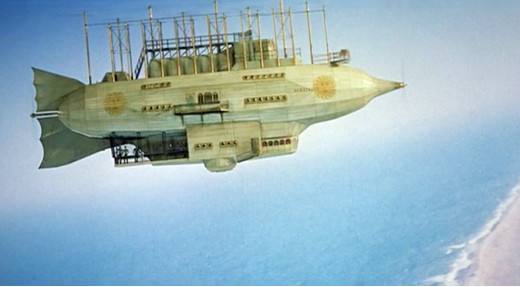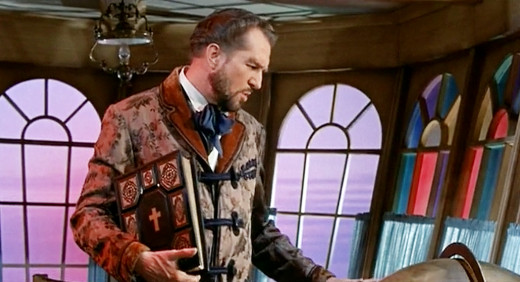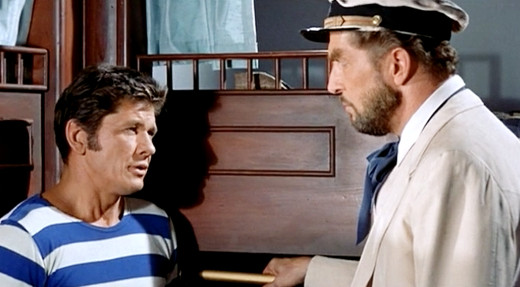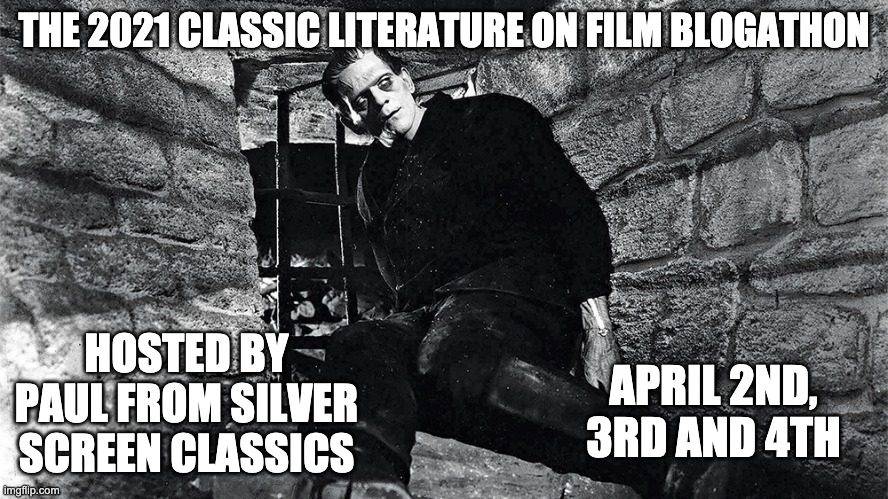Pros: Vincent Price and Charles Bronson give solid performances; The Albatross airship is impressive in exterior shots; Presents some interesting moral quandaries.
Cons: Cheap production values; Weak direction and editing; Comic relief scenes fall flat.
Note: I am participating for the second straight year in the "Classic Literature on Film Blogathon" hosted by Paul Batters at his Silver Screen Classics blog. Do the classy thing and after you finish this post, head on over there for some great perspectives on the always tricky business of adapting literary works to film. (If you're curious about what I did last year, see my post on Hawthorne's House of the Seven Gables.)
As I write this, NASA engineers are preparing for the first ever helicopter flight over the surface of Mars. To commemorate this interplanetary aviation first, they installed a small piece of fabric from the Wright brothers’ original airplane on the Ingenuity helicopter. Which is appropriate, since this new pioneering flying machine looks a little like something cobbled together by two guys in their bicycle shop.
 |
| "Mars base here, the Mosquito has landed!" |
It’s weird to imagine such a frail-looking contraption zooming over the surface of Mars (knock on wood that all goes well). The nerdy kid in me is tempted to think, “good grief, this is 2021, shouldn’t we be zipping from one Mars colony to another in hovercraft by now?”
On the other hand, there’s something mind blowing about operating a remote control helicopter on another planet.
I’m also tempted to think that Jules Verne, the venerable pioneer of science fiction, would have approved. Much like what the NASA people are doing, Verne used his fertile imagination to take the existing technology of the day, fiddle with it, and apply it in ways no one had thought of before.
 |
| Jules Verne, circa 1856 |
In From the Earth to the Moon (1865), he imagined a colossal cannon firing a manned projectile to the moon. In Around the World in Eighty Days (1872) his protagonist Phileas Fogg races across the globe on a bet, using the era's new transcontinental railroads and steamers. Ditto for submarines, where he extrapolated from the day’s primitive semi-submersibles to a powerful, spacious vessel that could travel Twenty Thousand Leagues Under the Sea (1870). [Editor's note: embarrassingly, my original summary of Around the World in Eighty Days confused
the movie's premise with the novel's; I have corrected it.]
Which brings us to Master of the World (1904) and Robur, the conqueror of heavier-than-air flight. The brilliant inventor actually figures in two Verne novels. Robur The Conqueror and his awesome aircraft The Albatross made their debut in 1886. In that novel Robur hijacks several influential members of the Weldon Institute, who had insisted that heavier-than-air flight would never be feasible, and makes believers out of them.
Robur returned in spectacular fashion in Master of the World, considerably upping the ante with a craft dubbed the Terror, capable of tremendous speeds on land, on and under the sea, and in the air.
With Disney having scored big with its lavish production of 20,000 Leagues Under the Sea in 1954, it was a sure bet that Robur would get his chance to do for the skies what Captain Nemo did for the seas on the silver screen.
American International Pictures (AIP), no doubt recognizing an opportunity to piggyback off of Disney’s success, teamed up with Alta Vista Productions to create their own megalomaniacal captain. They combined the two Robur novels and made the character a Nemo-esque fanatic who uses his formidable airship to try to enforce world peace. Master of the World took its maiden flight in theaters in 1961.
AIP tapped Vincent Price, fresh off his role as Roderick Usher in Roger Corman's House of Usher (1960), to play Robur. With his imposing stature and aristocratic demeanor, Price was a natural for the part. To add to the bigger than life effect, Price was outfitted with a tropical white suit, a full beard, and huge, Mephistophelian eyebrows. (The intimidation factor is mitigated, however, by Robur’s crumpled captain’s hat, which looks a bit like the Skipper’s from Gilligan’s Island.)
 |
| "You starched my underwear again, didn't you?" |
The film opens with a couple of citizens of Morgantown, PA, circa 1868, complaining about how their town is the most boring in the entire country. Right on cue, the ground shakes, thunder sounds, and eerie lights are seen over a nearby mountain. A booming, god-like voice is heard over the cacophony: “Harken ye people… for the indignation of the Lord is upon all nations, and his fury upon all their armies… he shall utterly destroy them.”
Cut to a meeting of the Weldon Balloon Society in Philadelphia, where John Strock (Charles Bronson), an operative for the U.S. Dept. of the Interior, is watching a debate between Mr. Prudent (Henry Hull), a wealthy arms manufacturer, and Phillip Evans (David Frankham), over whether a propeller should be placed in the front or the rear of a modified manned balloon.
Strock is there to commission the Society’s balloon to fly over the Pennsylvania mountain in an attempt to find out what was behind the weird events. The three men and Prudent’s attractive and spirited daughter Dorothy (Mary Webster) take off in the supposedly state-of-the-art balloon. As they float over the site, a rocket suddenly shoots out from a crater at the mountain’s summit, grazing the craft and forcing it down.
 |
| Prudent, the pompous industrialist, is master of all he surveys... until he meets Robur the Conquerer. |
Knocked unconscious by the crash, the four wake up to find themselves in what appears to be a spacious and well-appointed sailing ship. The befuddled group is taken by a crewmember to meet Robur, who calmly informs them that they are aboard an enormous airship, the Albatross, 150 feet long by 20 wide, weighing several tons, and capable of speeds up to 150 mph.
Robur takes the group on a tour, proudly explaining that the Albatross is powered by electricity generated by “dense metals cutting through magnetic force lines,” and that to save weight, the ship is largely made out of extruded straw paper mixed with clay and dextrin.
Prudent, old school to the core, blusters and snorts in disbelief, but there’s no denying that they’re in an enormous ship flying thousands of feet above the earth. When Prudent challenges Robur to turn himself and his fantastic invention into U.S. authorities, Robur tells him that he will do no such thing, that he is a citizen of the world, loyal to no country. Moreover, he has declared war on war, and intends to use his ship to force the world’s nations to disarm.
Robur proves that he is in deadly earnest when, as the Albatross is flying across the Atlantic, they encounter an American warship. Through the ship’s voice amplifier Robur warns the crew to abandon ship, but when the warship fires its cannons, he sinks it with some well-placed bombs.
Outraged, Evans and Prudent want to try to escape at the first opportunity, but Strock is skeptical that it can be done. He thinks the better part of valor is to stay onboard and observe Robur and the ship’s capabilities before doing anything rash. Hot-headed Evans accuses Strock of being a coward, or worse yet, a collaborator. But his feelings may have more to do with Dorothy’s obvious attraction to Strock.
 |
| The crew of the Weldon Society balloon are a little worse for the wear after their encounter with one of Robur's rockets. |
Eventually, the four prisoners agree to take action against Robur, but before arriving at their do or die moment, they have ringside seats as the madman sinks English warships at harbor near London, and intercedes in a North African war by bombing the two opposing armies.
When Master of the World opened in 1961, ads proclaimed that it was “In the tradition of “20,000 Leagues Under the Sea” and “Around the World in 80 Days.” To continue the tradition, the producers and screenwriter Richard Matheson took Verne’s Robur, who was primarily concerned with demonstrating his brilliance to lunk-headed skeptics, and turned him into a fanatical Nemo knock-off with far more grandiose plans to make war-loving nations bend to his will.
Unfortunately, AIP’s ambitions far exceeded its resources. Cheapness rears its ugly head at every turn through the film’s 102 minute run time. In the opening scene, Robur’s god-like demonstration at the Pennsylvania mountain features a particularly unconvincing backdrop painting. Later, paintings rather than models are mainly used as stand-ins for the warships that Robur sinks. Much of the other action and spectacle is accomplished via rear projection or stock footage.
The exterior of the Albatross is impressive enough; the ship is dirigible-shaped with bright orange anthropomorphic suns painted on its sides, large propellers fore and aft, huge fish-like fins at the stern and a small forest of helicopter blades on its topside (not to mention the bomb bay door underneath). But the interiors, with the exception of Robur’s cabin, look more like a 19th century boarding house than a stately clipper of the air (after the Weldon group is abducted but before they figure out what sort of craft they’re being held on, Prudent guesses that it’s a riverboat). An airborne Nautilus it is not.
 |
| The Albatross soars over the coast of Ireland. |
Moreover, the ambitious premise is frittered away with long stretches of the captives bickering and blustering among themselves, and an unfortunate stab at comic relief featuring the ship’s French chef (Vito Scotti), complete with a comically thick accent, who keeps getting banged in the head with his pots and pans whenever the airship makes sudden maneuvers.
William Witney’s indifferent direction doesn’t help matters. Inexplicably, several exchanges between the protagonists on the exterior deck of the airship are shot with a heavy wire mesh in the foreground (at least Robur was safety-conscious). Witney also has a bad habit of shooting principal characters from the back even as they’re delivering impassioned lines.
Still, I wouldn’t write about Master of the World if there wasn’t something to like. Matheson includes an interesting aviation variant of the cruel sailing tradition of keelhauling. After the captives’ first escape attempt, Robur makes examples of Evans and Strock by tying them up with ropes and lowering them from the bomb bay door. He then proceeds to fly low over a mountain range, to the point where the men have to push off from outcroppings with their feet to avoid being smashed.
The love triangle between Dorothy, Evans and Strock is also a nice touch. Even though Strock saves Evans’ life early on, the simmering tension, which is constantly threatening to erupt into all-out conflict, suggests that Evans might not return the favor when the time comes. Fans of Charles Bronson will appreciate his signature cool, steely resolve, punctuated by an occasional disarming grin, which makes for a good contrast to Evans’ bombastic hotheadedness. (On the other hand, veteran Henry Hull almost comically overplays the gruff Prudent, as if he were delivering his lines in an actual 19th century melodrama.)
 |
| Robur contemplates his divine mission to rid the world of war. |
The film also greatly benefits from Vincent Price’s nuanced performance. Robur’s mission stems from deep-seated religious convictions. The Albatross is not only a means for him to end war, but is also a sacred sanctuary. Some of the windows on the bridge and in Robur’s stateroom are stained glass, giving the ship a church-like ambience. At one point, Robur clutches a Bible in his hand as he inscrutably gazes down at a globe.
But if you’re going to wage war against war, there are probably going to be internal conflicts. Innocent people die in wars. Robur gives fair warning to the crews of the warships he’s about to sink, but when they fire on the Albatross in self-defense, he grits his teeth and sends the ships straight to the bottom with all hands.
Robur is similarly ambivalent about his captives. He first tries to kill the Weldon group by downing their balloon with a rocket, but then, finding that they’ve survived the crash, brings them aboard the airship and proceeds to play the civilized host.
And even as he decides to “keelhaul” the rebellious Evans and Strock, he’s stricken by a pang of conscience. As the men are dangling precariously beneath the ship, Robur is preoccupied on the bridge. When he realizes that he’s forgotten all about them and they’re in danger of being smashed against the rocks, a look of sheer panic crosses his face and he rushes down to the hold to rescue them.
 |
| Charles Bronson and Vincent Price made just two films together: House of Wax (1953) and Master of the World. |
In his detailed review of Master of the World, sci-fi movie historian Bill Warren lauds Price’s performance:
“Vincent Price has one of his best roles as Robur the Conquerer. Although clearly the intent was to create a Nemoesque figure, Price’s Robur is at once more lofty and congenial than Nemo. He’s in love with the Albatross, and delighted to share this love with others; Nemo was jealous of the Nautilus. Price seems more controlled here than in his other AIP films of the time, although his best performances for them would be in the two Corman-Poe films made in England, Masque of the Red Death and Tomb of Ligeia. Price has a strong tendency to go over the top, but keeps it check here, and his Robur is more than adequate, though not as vivid as James Mason’s Nemo.” [Bill Warren, Keep Watching the Skies, Volume II, McFarland, 1986, p. 566]
Apparently Price greatly enjoyed playing Robur. Warren cites a quote of the actor’s in Vincent Price Unmasked (Steven Whitney and James Robert Parrish, Drake Publishers, 1974):
“I loved Master of the World because I thought it had a marvelous moralizing philosophy. I adored it. It was of a man who saw evil and wanted to destroy it. And if that meant the whole world, then it had to go.” [Ibid., p. 566]
Price’s enthusiastic portrayal, combined with Charles Bronson’s solid presence, serves to mitigate, if not overcome, the film’s cheap production values and weak direction. And they’re backed up by the Albatross itself, which is impressive and retro-looking at the same time.
Master of the World pales in comparison to adaptations like Disney’s 20,000 Leagues Under the Sea, but it does grapple with some sophisticated ethical and moral quandaries while at the same time providing a thrill or two 6,000 feet above the sea.
Where to find it: Streaming; DVD
 |


I don't know how I missed this one over the years. It sounds like fun with expectations kept low to enjoy its finer points.
ReplyDeleteIt's fun to watch Charles Bronson, who by this point had established the persona that became so famous in the '70s, mixing it up with Vincent Price, who obviously relished the role.
DeleteThe Albatross really impressed me when I was a kid -- I wanted a model of it so badly, but never found one. :)
I think your review is pretty fair. I liked this movie, even with its flaws. And yes, Vincent Price is excellent.
ReplyDeleteThanks! After finishing the review I wondered if I was a little too hard on it. I committed to the film for the blogathon not having seen it in some time. The first time around I was more disposed to overlook its faults. Still, there's a pretty good adventure film there, hiding behind its low budget. Price's enthusiasm for the role saves it to a great degree.
DeleteMaster of the World doesn't get the love it deserves, so thank you for this post!
ReplyDeleteYes it has cheap, AIP production values (I'm always amused by how Robur is flying over ELIZABETHAN London), but I think it actually delivers more successfully on the same core ideas of Disney's 20,000 Leagues. Disney's Nemo is an aristocrat driven by a rather pedestrian motive of revenge, which plays out pretty straightforwardly against the heroics of Ned Land. In Master of the World, Robur is truly driven by his ideology, and its the contradiction between his ideology and his methods that ultimately leads to his downfall (quite literally). His crew are actual characters and you get a much better sense of how he cares for them and they for him. And you're not really sure if Strock is such a hero, given how shifty he is and the fact that IS working for the US government after all. I love both films, but AIP's is surprisingly more nuanced and fulfilling given its limitations.
Point of order though: there is no hot air balloon in the Around the World in 80 Days novel. That was just for the movie ;)
Hi Cory! First of all, thank you for your point of order! With much egg on my face, I have corrected the summary and made a note of the original error. It's a lesson in how much of our (or should I say my) "knowledge" of literature comes from the movies. :)
DeleteIndeed, Nemo's motivations are far more personal, and from the perspective of a lofty idealist like Robur, he'd be seen as more part of the problem than a soulmate. And yes, Strock is cagey and keeps his fellow characters and the viewer guessing. But it's Chuck Bronson after all, and I just knew he wouldn't let me down! ;)
Without going into too much revelatory detail, the crew's demonstrated love and loyalty for Robur, as you point out, is very touching.
Thanks for visiting!
I've NEVER heard of this and it sounds like an absolute gem of a film and a lot of fun. You're spot on that they would have seen this as a winner given the success with 20,000 Leagues Under The Sea. Not to mention having a legendary actor like Vincent Price who is perfect for the role of Robur. If he enjoyed the role so much, I'm sure that it's transferred onto the screen as well.
ReplyDeleteThank you so much for taking part and sharing this film. I'm looking forward to seeing it!
Hi Paul! Vincent Price does indeed do a great job of portraying a man who is outwardly righteous and certain in his convictions, and yet at the same time is troubled by the consequences of his actions. I can see how Price, at that point in his career, would relish a role like that.
DeleteThanks so much for organizing the blogathon and letting us share!
I'm another one who hasn't seen this film, despite the presence of the fab Vincent Price. If this film is half as enjoyable as your review, I know I'll like it very much.
ReplyDeleteThanks so much! I'm finding quite a few people, even Vincent Price and/or classic sci-fi fans, who have somehow missed it. (I suppose Charles Bronson fans could be forgiven for overlooking it, as it's pretty far outside the genres he's known and loved for. :) It's definitely worth a look, and fortunately it's available on DVD and streaming (Amazon).
DeleteI've seen this film since the late 60s, and in fact have a paperback containing both novels, and Vincent Price's photo on the cover! Some time back I taped it off TCM (so it was a nice widescreen print), but now I have the Shout Factory Blu-Ray. I don't mind the minor damage, what weirds me out more is that apparently the sound volume DROPS in the middle of the picture but then jumps back up for the last third. (Anyone else notice that?)
ReplyDeleteI love the design of the Albatross; I just kept wishing they'd done some kind of camera tracking shots where it would be seen to MOVE as opposed to just hovering in front of the backgrounds. I think the single BEST visual effect is when it BLOWS up at the end! This comes, unfortunately, without an actual shot of it first crashing into the ocean (heh).
Henry Hull's performance harkens back to the one he gave in JESSE JAMES and THE RETURN OF FRANK JAMES, but I liked his character there. David Frankham is just such a JERK in this. He nicely toned it down a lot when he appeared in TALES OF TERROR.
Personally, I have no problem with Bronson's performance here. Although, in 19th century sci-fi terms, Robert Conrad does seem like he would have been a better fit (heh).
This is a "nice" movie, but it'll never be a great one. I'd say, something to re-watch maybe every 10 years... as opposed to yearly, or every 6 months. There are WAY-better Jules Verne films out there (and I'm planning to go after as many as I can find!), but, there are also far-worse ones.
I'm waiting for someone to do a proper full restoration on the 1929 "THE MYSTERIOUS ISLAND"-- the PREQUEL to "20,000 Leagues"-- which features a fictionalized version of the Bolshevik Revolution (the Czars, the democratic types, and the criminals who over-ran the country). Verne intended Nemo to be a Polish prince betrayed by the Russians, but his editor felt that would hurt sales at the time, so in anger, he just removed all references to his background, leaving Nemo a total mystery. (The "sequel" was NEVER intended as one when he wrote it, which explains its insane inconcisistencies. The 1961 movie with Herbert Lom is WAYYY better than Verne's novel!) Currently, the 1929 film is only available on a Warner Archive DVD in "unrestored" status, which-- infuriatingly-- does NOT look as good as the videotape I recorded decades earlier off of TNT! There's NO excuse for that.
Thanks for sharing your thoughts Henry! I agree that, while not great, Master of the World is definitely worth a look for those who haven't seen it, and an occasional fun re-watch for those who have. The Albatross design is something special, but unfortunately AIP didn't have enough money to back up the ship -- and the energetic cast -- with state of the art effects for the time.
DeleteThe 1929 Mysterious Island sounds very intriguing -- here's hoping it gets a deserved restoration!